Are Ceramic Glazes Food Safe? The Truth Behind the Shine
Time of issue: 2025-10-09 16:30:39- What Does “Food Safe Ceramic Glaze” Mean?
- The Science Behind Food-Safe Glazes
- U.S. Rules for Food Safety in Pottery
- What Makes a Ceramic Glaze Food Safe?
- Common Problems with Unsafe Glazes
- How to Test if a Ceramic Glaze is Food Safe
- Tips for Shoppers and Home Use Before Buying
- FAQs About Food-Safe Glazes
- Question: Can vintage pottery be used for food?
- Question: What happens if a ceramic glaze isn’t food safe?
- Question: Does “non-toxic” glaze mean it’s food safe?
- Question: Can I test my pottery at home for food safety?
- Question: Are handmade mugs and bowls safe to use?
- Question: Why do some glazes leach into food?
- Question: Is crazing in pottery dangerous?
- Question: How do I safely use pottery if I’m unsure about the glaze?
- Final Thoughts
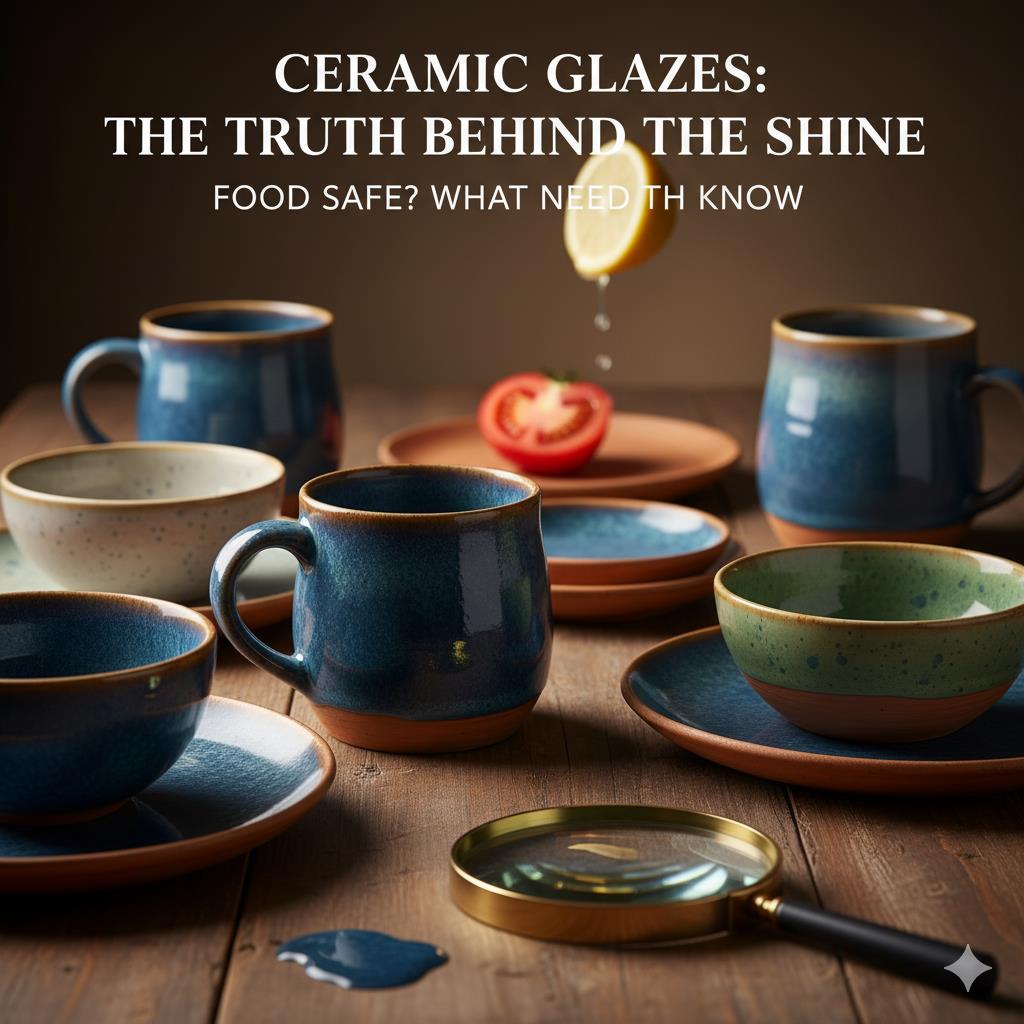
Yes, ceramic glazes are food safe, but only if they’re formulated and fired correctly. Ceramic glazes are an extra layer over ceramic products to make them shiny and prevent leaking. That means when a piece is glazed and fired correctly, you can safely use it for your morning coffee, soup, or dinner without worry.
Glazes are made from minerals and oxides, and they go through a formula and firing. If any of these go wrong, chances are your favourite coffee mug or soup bowl isn’t safe for you anymore. Studies have shown that poorly made or vintage ceramics can leach metals like lead or cadmium when they come into contact with food. That’s why knowing the difference between safe and unsafe glazes is so important. You can’t always tell if a ceramic glaze is food safe just by looking at it, but there are several ways to check.
At Global Reach Ceramic, we’re here to help you enjoy ceramics that aren’t just beautiful to look at, but safe to share around the table too.
What Does “Food Safe Ceramic Glaze” Mean?
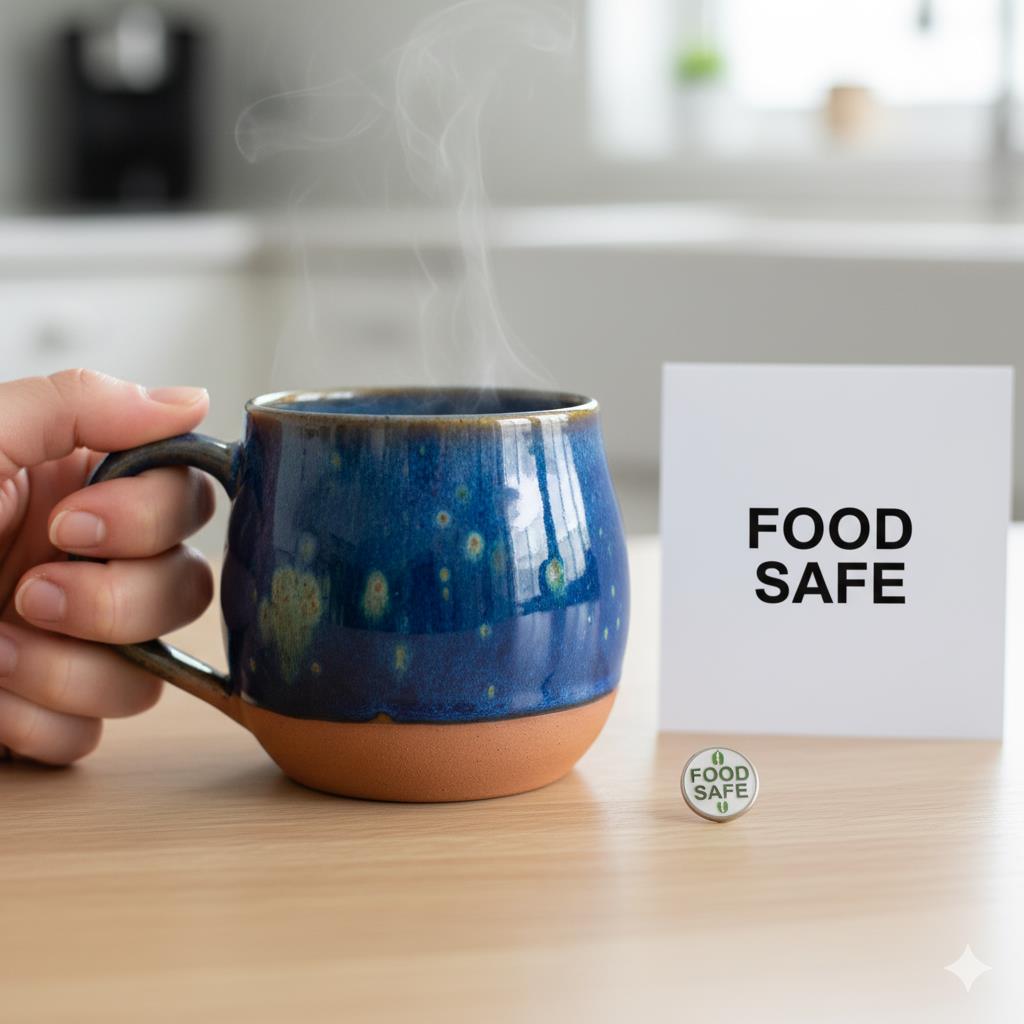
If you’ve ever picked up a handmade mug and wondered, “Is this actually safe to drink from?”. You’re really asking about the glaze. A food safe ceramic glaze simply means the shiny (or sometimes matte) coating on the surface won’t leak anything harmful into your food or drink.
Here’s the tricky part: not every glaze that looks pretty is truly food safe. Glazes are made from minerals and oxides, and if they’re not fired correctly or if the formula isn’t stable, bits of those materials can slowly leach out when they meet something acidic, like coffee, orange juice, or tomato sauce.
People also toss around similar terms that can be misleading:
- Food Safe → Safe for actual contact with food and drink.
- Dinnerware Safe → More about durability (microwave, dishwasher). Doesn’t always guarantee chemical stability.
- Non-Toxic → Sounds good, but only means the raw glaze ingredients aren’t poisonous to handle.
Think of it like this: a glaze is basically a thin sheet of glass melted onto clay. When it’s stable, it’s tough, smooth, and safe. When it’s not, it can crack, craze, or leach things you don’t want in your latte.
The Science Behind Food-Safe Glazes
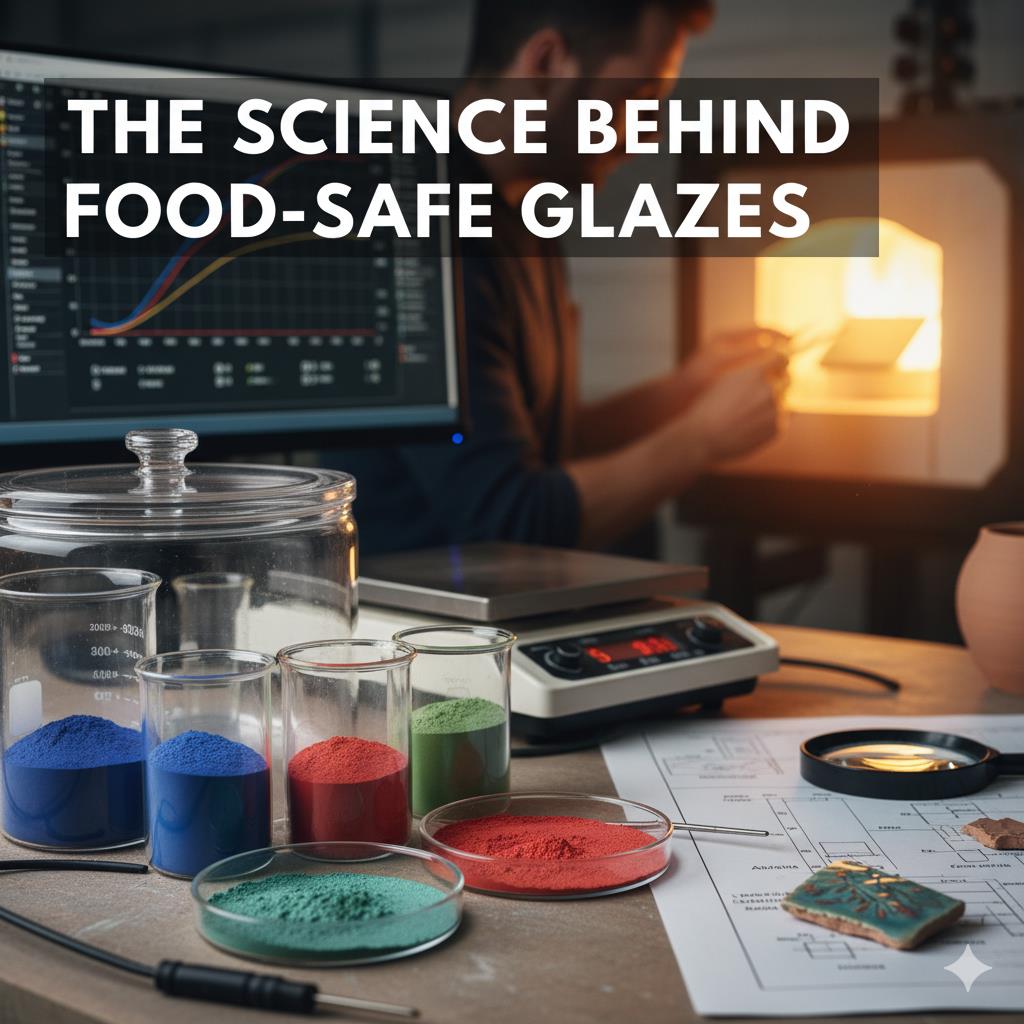
A ceramic glaze is basically a thin layer of glass melted onto the clay during firing. It makes pottery waterproof, durable, and, if done right, safe to eat from.
Think of glaze as a recipe with a few key ingredients:
- Silica – the part that turns into glass.
- Alumina – keeps the glaze from running off the pot in the kiln and adds strength.
- Fluxes – minerals that help the glaze melt at the right temperature.
On top of those basics, potters add colorants like cobalt for blue, copper for green, or iron for reds and browns. These give pottery its beauty but they’re also the elements that can cause problems if the glaze isn’t stable.
The kiln is where the magic happens. If a glaze is fired too low, it may not fully melt, leaving a surface that looks fine but can leach metals when it touches acidic foods like coffee, wine, or tomato sauce. Fire it too high, and the glaze can run, bubble, or even weaken. The sweet spot? Just the right temperature so everything bonds into a strong, glassy layer.
U.S. Rules for Food Safety in Pottery
In the United States, pottery and ceramics that are made for eating and drinking don’t just rely on trust. They’re backed by regulations. The Food & Drug Administration (FDA) has clear rules to make sure glazes don’t release harmful substances when they come into contact with food.
The focus is on two metals:
- Lead → once used for glossy, bright finishes
- Cadmium → often used for bold reds, yellows, and oranges
The problem is that, if they aren’t fully locked into the glaze during firing, they can leach into whatever you put in the dish. Over time, even small amounts can build up in the body and cause health problems.
Here’s a simple breakdown of the FDA limits for lead and cadmium release:
| Item Type | Lead Limit (µg/mL) | Cadmium Limit (µg/mL) |
| Flatware (plates) | 3.0 | 0.25 |
| Small hollowware (cups, bowls) | 2.0 | 0.5 |
| Large hollowware (serving bowls, pitchers) | 1.0 | 0.5 |
These limits aren’t just suggestions. Manufacturers and potters selling food-contact ceramics must make sure their wares pass these tests.
What Makes a Ceramic Glaze Food Safe?
A food safe ceramic glaze is one that acts like a protective shield. When it’s done right, the glaze forms a hard, glassy surface that keeps food and drink from touching the clay underneath and more importantly, it doesn’t let anything harmful sneak back into your meal.
It starts with the ingredients. Every glaze is a mix of silica (the glass part), alumina (the stabilizer), and fluxes (the melters). Add colorants like cobalt for blue or copper for green, and you’ve got something beautiful. But here’s the catch: those same colorants can be risky if they aren’t fully locked into the glaze structure.
Next comes the firing process. The kiln is where everything either comes together or falls apart. Fire too low, and the glaze doesn’t fully melt, leaving it unstable. Fire too high, and it can run, blister, or weaken. Fire it just right, and you get a dense, sealed surface that resists acids, scratches, and daily use.
Finally, you need a smooth finish. A food-safe glaze won’t have crazing (those tiny spiderweb cracks), pinholes, or rough spots. These flaws might look harmless, but they give food acids and bacteria a way in, and that’s when problems start.
In short, what makes a glaze food safe is balance: the right recipe, the right firing, and a flawless surface. When all three line up, you get pottery that’s safe to eat from and strong enough to last.
Common Problems with Unsafe Glazes
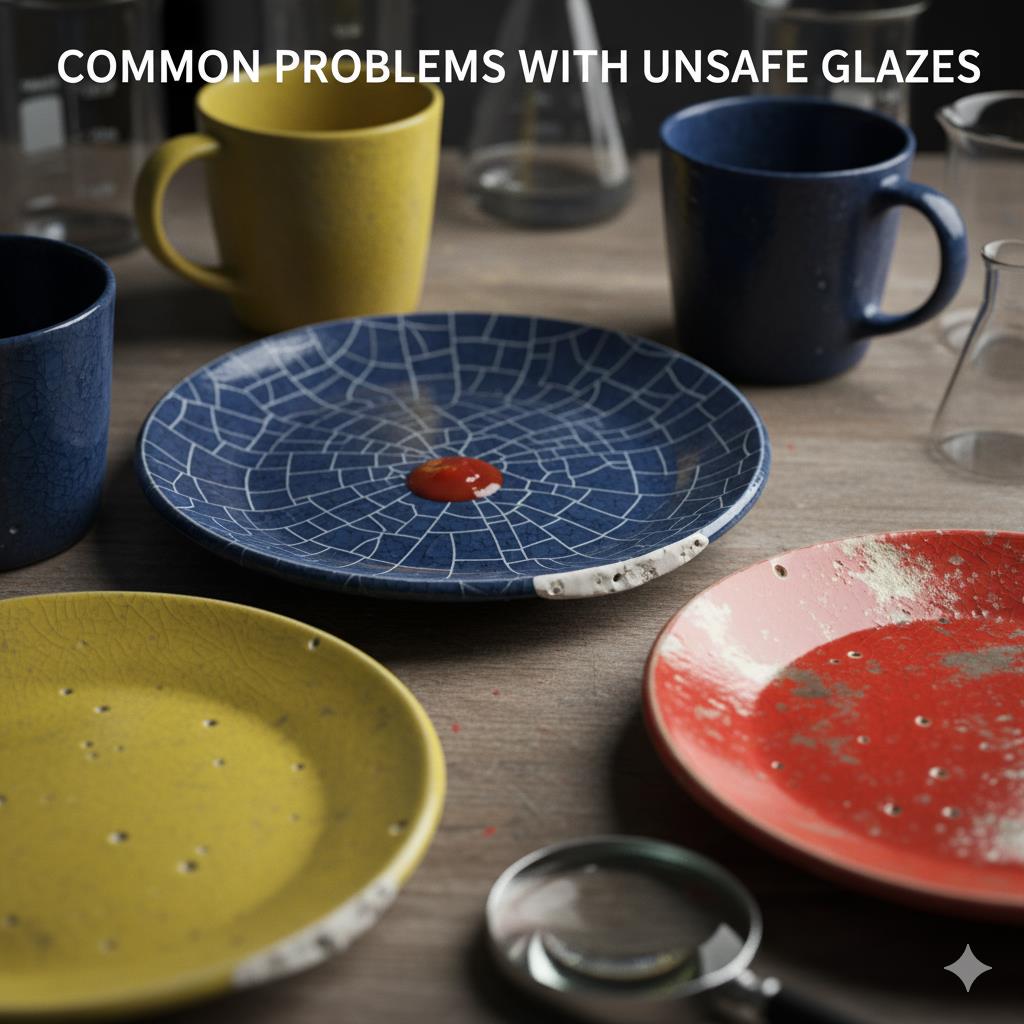
- Crazing: Those little spiderweb cracks in the glaze? They might look cool, almost antique, but they’re trouble. Food and liquids can seep into those cracks, and over time they can carry out metals or even grow bacteria.
- Leaching: This is when the glaze actually starts giving something back. But not in a good way. Acidic foods like coffee, wine, or tomato sauce can pull materials out of the glaze. That’s when you end up with weird stains, fading colors, or even a metallic taste.
- Pinholes and pits: If the surface isn’t smooth, food and germs will find their way into every little nook. Those tiny holes may look harmless, but they’re basically hiding spots that make cleaning impossible.
- Soft matte finishes: Matte glazes can be gorgeous, but some don’t hold up. If they’re too soft, they can wear down, exposing the clay underneath. And once the clay is exposed, it’s game over for food safety.
- Bright old colors: Those vintage reds, oranges, and yellows? They pop, for sure. But many older glazes used lead to get those colors, and that’s not something you want mixing with your dinner.
How to Test if a Ceramic Glaze is Food Safe
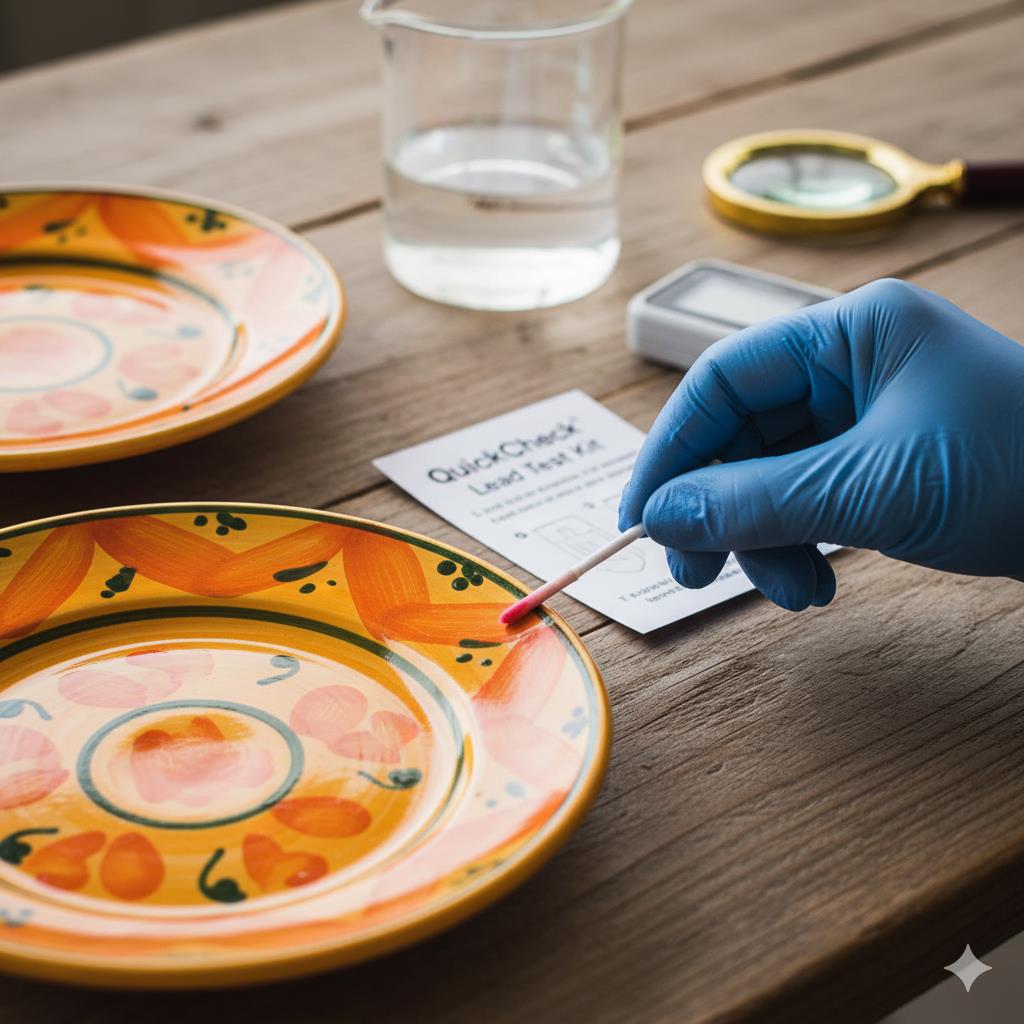
You can’t always tell if a ceramic glaze is food safe just by looking at it. A shiny mug or colorful bowl might seem fine, but that doesn’t mean it’s safe to eat from. Luckily, there are a few ways you can check.
Lab Testing (The Gold Standard)
If you want a 100% clear answer, send the piece to a lab. They’ll soak it in a strong acidic solution and then test the liquid to see if anything harmful, like lead or cadmium, has leached out. It’s the most accurate method and the one potters rely on if they’re selling their work. The downside? It costs money and takes time.
At-Home Test Kits (Quick Check)
You can buy lead and cadmium test kits online or at most hardware stores. They’re usually swabs that change color if metals are present. These kits are cheap and easy, which makes them great for checking old or imported ceramics. Just keep in mind they’re not perfect. They can miss low levels of leaching, so a “negative” result doesn’t always mean the piece is 100% safe.
The Lemon or Vinegar Test (Old-School Trick)
A lot of potters use this quick method. Fill the piece with lemon juice or vinegar and leave it overnight. If the glaze changes color, dulls, or leaves a strange metallic taste, that’s a bad sign. But if nothing happens, it doesn’t guarantee the glaze is safe. It just didn’t show obvious problems.
Things You Can Spot by Eye
Even without tests, there are red flags to watch for. Tiny cracks in the glaze (called crazing), little pinholes, chalky matte textures, or worn spots can all mean trouble. Bright vintage colors like reds, yellows, and oranges are also worth being cautious with, since older glazes often used lead.
Tips for Shoppers and Home Use Before Buying
- Start with the label → Look for pieces clearly marked food safe. If there’s no label, don’t be shy. Ask the maker or seller.
- Trust your touch → Run your fingers across the surface. Smooth and glassy feels safe. Rough spots, cracks, or pinholes? Skip it for meals.
- Think about age and style → Vintage pieces (especially bold reds, oranges, or yellows) may have older glazes that aren’t safe today.
- Watch the finishes → Shiny and sealed is your friend. Matte, rustic, or chalky glazes might look cool, but can absorb food or leach.
- Choose reliable sources → Established potters, studios, or brands usually know their glazes and fire them properly.
- Be cautious with “mystery finds” → That gorgeous flea-market bowl? Perfect for fruit or flowers, not soup.
- Have a backup plan → Unsure about a piece? Use it decoratively instead of at the dinner table.
Remember: pottery can be both beautiful and practical. Just make sure the pieces you eat from are ones you can trust.
FAQs About Food-Safe Glazes
Question: Can vintage pottery be used for food?
Answer: It’s risky. Many older pieces used lead-based or cadmium-based glazes. Even if they look fine, acidic foods can pull those metals into your meal. Vintage pottery is best for display, not eating.
Question: What happens if a ceramic glaze isn’t food safe?
Answer: Unsafe glazes can leach metals into food, give off a metallic taste, or stain from acidic foods. They may also trap bacteria in cracks or rough surfaces.
Question: Does “non-toxic” glaze mean it’s food safe?
Answer: Not always. “Non-toxic” usually refers to handling the raw glaze materials before firing. A glaze can be labeled non-toxic in the jar but still leach harmful materials once fired if it isn’t stable.
Question: Can I test my pottery at home for food safety?
Answer: Yes, to a point. Lead test kits are available and can give you a quick indication, but they aren’t always accurate. The only reliable method is lab testing for leaching.
Question: Are handmade mugs and bowls safe to use?
Answer: They can be but only if the potter used a food safe glaze and fired it correctly. Always check with the maker or look for a clear food safe label.
Question: Why do some glazes leach into food?
Answer: Leaching happens when the glaze isn’t stable. This can be caused by the wrong recipe, under-firing in the kiln, or using too much of certain colorants like copper or cobalt.
Question: Is crazing in pottery dangerous?
Answer: Yes. Crazing looks like tiny cracks in the glaze. While it can seem decorative, it allows acids, liquids, and bacteria to get into the surface, making it unsafe for food use.
Question: How do I safely use pottery if I’m unsure about the glaze?
Answer: If you’re not sure, don’t eat or drink from it. Use it as a planter, a fruit bowl for unpeeled items, or simply as decoration.
Final Thoughts
So here’s the bottom line: not every shiny mug or pretty bowl is safe to eat from. A food safe glaze is smooth, strong, and locked in place. no cracks, no leaching, no hidden surprises. When the glaze isn’t right, it might still look beautiful, but it’s better left as a display piece than a dinner plate.
If you stick with trusted pieces, you can enjoy pottery every day without second-guessing. And that’s what we’re all about at Global Reach Ceramic: helping you find ceramics that are gorgeous and safe enough to hold your morning coffee or family meals with total confidence.
RECENT POSTS
- The Impact of Ceramic Materials in Energy-Efficient Buildings: Benefits and Applications
2025-12-04
- Top 7 Ceramic Cookware Health Benefits: Why It’s a Safer Choice for Your Kitchen
2025-12-04
- How to Clean Ceramic Planters and Improve Their Lifespan?
2025-11-17
- 15 Best Ceramic Holiday Gift Ideas for 2025: Thoughtful, Elegant & Heartfelt
2025-11-17
- Stoneware vs Porcelain vs Earthenware: Quick Decision Guide
2025-10-09
- Are Ceramic Glazes Food Safe? The Truth Behind the Shine
2025-10-09
- Christmas Decoration Trends That Wow Every Guest
2025-09-18
- Halloween Decoration Trending Ideas with Ceramics For 2025-26
2025-09-18










